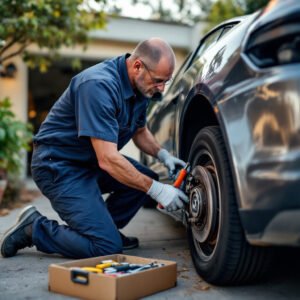Replacing your car’s shock absorbers is a fantastic DIY project that can transform your driving experience. Worn shocks lead to a bouncy ride, poor handling, and even safety risks like longer braking distances. The best part? You don’t need a professional garage or fancy equipment—just some basic tools, a little time, and this guide. In this detailed 2000+ word article, I’ll walk you through every step of the process, explaining each point thoroughly so you can tackle this repair with confidence. Whether you’re a first-timer or a seasoned DIYer, you’ll find maximum value here to get the job done right.
Why You Should Replace Your Shock Absorbers
Shock absorbers are unsung heroes of your car’s suspension. They absorb the jolts from potholes and bumps, keeping your tires glued to the road and your ride smooth. Over time—usually between 50,000 and 100,000 miles—they wear out. How do you know it’s time? Look for these signs:
-
- Excessive Bouncing: Hit a bump, and your car keeps jostling like a trampoline.
-
- Nose-Diving: The front dips sharply when you brake.
-
- Uneven Tire Wear: Worn shocks can’t keep tires in consistent contact with the road.
-
- Rough Ride: Every crack in the pavement feels like a punch.
Fixing this yourself saves you hundreds compared to a shop’s labor fees (think $300–$600 vs. $100–$300 for parts alone). Plus, you’ll gain hands-on skills and pride in keeping your car road-ready. Let’s dive in!
Tools and Materials You’ll Need
You don’t need a mechanic’s toolbox—just everyday gear. Here’s what to gather, with explanations for each:
-
- Jack and Jack Stands: A floor jack lifts the car; stands hold it safely. Don’t rely on the jack alone—it’s not stable enough for work underneath.
-
- Lug Wrench: This removes wheel lug nuts. Your car’s spare tire kit probably has one—a four-way cross wrench works great.
-
- Socket Wrench Set: You’ll need various sizes (e.g., 13mm, 17mm, 19mm) for shock bolts. Check if your car uses metric or imperial sizes.
-
- Open-End Wrenches: These pair with your sockets to hold bolts while you turn nuts. Match the sizes to your socket set.
-
- Pliers: Handy for removing clips or cotter pins that might secure bolts.
-
- Penetrating Oil (e.g., WD-40 or PB Blaster): Loosens rusty bolts—essential for older cars.
-
- Torque Wrench: Ensures bolts are tightened just right (not too loose or too tight). Borrow one if you don’t own it—precision matters.
-
- Screwdrivers (Flathead and Phillips): For prying or removing small clips or covers.
-
- Rubber Mallet or Hammer: Gently taps stuck parts loose without damage.
-
- Safety Gear: Gloves keep grease off your hands, safety glasses protect your eyes, and sturdy shoes guard your feet.
-
- New Shock Absorbers: Buy ones specific to your car’s make, model, and year—front and rear might differ. Check your manual or a parts store.
-
- Replacement Hardware: New shocks might include nuts and bolts; if not, grab what matches the old ones.
Optional but Useful:
-
- Spring Compressor: Only needed for struts (shocks with coil springs—more on this later). Rentable for $20–$30.
-
- Pry Bar: Extra leverage for stubborn parts.
-
- Shop Rags: Keeps your workspace tidy and your hands clean.
Cost? Shocks range from $50–$150 each, depending on your vehicle. If you’ve got the tools already, that’s your biggest expense—way less than a mechanic’s bill.
Preparation: Setting Up for Success
Before you touch a bolt, prep like a pro. Here’s how to start safely and smartly:
-
- Park on a Flat Surface: A level driveway or garage prevents the car from rolling. Set the parking brake and, if you’re roadside, turn on hazard lights.
-
- Gather Everything: Lay out your tools and parts. Confirm the shocks match your car—mix-ups happen, and you don’t want to be stuck mid-job.
-
- Check Your Manual: Your owner’s manual or a repair guide (like Haynes, available at auto stores) lists torque specs and model-specific tips. It’s your cheat sheet.
-
- Gear Up: Slip on gloves, safety glasses, and closed-toe shoes. Grease and falling dirt are no joke.
Now, you’re ready to roll—literally.
Step-by-Step Guide to Replacing Shock Absorbers
We’ll focus on standard shock absorbers (not struts—those get their own section later). Most cars have shocks in the rear and struts up front, but verify your setup. Replace them one at a time for simplicity, and do both on the same axle for balance. Here’s the breakdown:
Step 1: Lift and Secure the Car
Lifting your car safely is the foundation of this job. Take it slow:
-
- Loosen Lug Nuts: Grab your lug wrench and turn each lug nut counterclockwise about half a turn. Do this while the car’s on the ground—the weight keeps the wheel from spinning.
-
- Jack Up the Car: Find a solid lift point near the wheel (check your manual—often a frame rail or pinch weld). Slide the jack under, pump it up until the tire’s an inch off the ground.
-
- Remove the Wheel: Finish unscrewing the lug nuts by hand, pull the wheel off, and lay it flat nearby so it doesn’t roll away.
-
- Add Jack Stands: Slide a jack stand under the same lift point or a nearby sturdy spot (like the axle). Lower the jack slowly until the car rests on the stand. Tug the car lightly—it shouldn’t wobble. Never work under a car held only by a jack; it could collapse.
Repeat for the other side if you’re doing both shocks on this axle.
Step 2: Locate and Inspect the Shock Absorber
Time to find the star of the show:
-
- Spot the Shock: Look between the axle (or suspension arm) and the car’s frame/body. It’s a cylinder with a sliding piston, bolted at both ends—top to the frame, bottom to the suspension.
-
- Assess Condition: Are the bolts rusty? Spray them with penetrating oil and wait 5–10 minutes. Rust can make removal tough, so this step saves headaches.
-
- Note Orientation: Some shocks have a “top” or “bottom”—check the new one’s instructions or markings. A quick photo here helps later.
Step 3: Remove the Old Shock Absorber
Let’s get that old shock out:
-
- Upper Mount: Start at the top bolt (on the frame). Fit your socket wrench on the nut and an open-end wrench on the bolt head to keep it still. Turn counterclockwise to loosen. If there’s a rubber bushing or washer, note their order—they’ll go back the same way.
-
- Lower Mount: Move to the bottom bolt (on the axle or arm). Same deal—socket on the nut, wrench on the bolt. If it’s stuck, spray more oil or tap it lightly with a hammer.
-
- Free It: With both bolts out, wiggle the shock loose. If it resists, use a screwdriver to pry or a rubber mallet to nudge it off. Don’t force it—gentle persistence wins.
Compare the old shock to the new one. Length, mounting holes, and bushings should match. If not, you’ve got the wrong part.
Step 4: Install the New Shock Absorber
Now, the fresh shock goes in:
-
- Position It: Slide the new shock into place, lining up the top and bottom mounts. Add bushings or washers in the same order as before.
-
- Hand-Tighten Bolts: Start the bolts by hand to avoid cross-threading (when threads misalign and strip). Snug them with your wrench, but don’t fully tighten yet—final torque comes later.
-
- Check Fit: Tug lightly. The shock should sit flush without binding or twisting as the suspension moves.
Step 5: Reattach the Wheel
Back to ground level:
-
- Mount the Wheel: Lift the wheel onto the hub, align the lug nut holes, and hand-tighten the nuts to hold it.
-
- Lower the Car: Raise the jack slightly, remove the jack stand, and lower the car slowly until the tire touches down.
-
- Tighten Lug Nuts: Use the lug wrench in a star pattern (e.g., top, bottom, left, right) to snug the nuts evenly. Don’t crank too hard yet—final tightening waits.
Step 6: Repeat for the Other Side
Do the exact same steps for the opposite shock on this axle. Replacing in pairs keeps your car balanced—doing just one can make it pull or wear unevenly.
Step 7: Final Tightening and Torque
With the car on the ground, lock everything in:
-
- Torque Shock Bolts: Use your torque wrench on the upper and lower bolts. Check your manual for specs (e.g., 20–70 ft-lbs). Too loose, and they’ll rattle free; too tight, and you’ll damage parts.
-
- Torque Lug Nuts: Tighten the lug nuts to spec (usually 80–120 ft-lbs) in a star pattern. This ensures the wheel sits flat and secure.
Step 8: Test and Inspect
Make sure it all works:
-
- Bounce Test: Push down hard on each corner. It should rebound once and stop. More bouncing? Recheck your bolts or shock fit.
-
- Road Test: Drive a familiar route. Feel for smoothness, listen for clunks, and note handling. It should feel better than before.
-
- Final Look: After driving, check all bolts and nuts. Tighten anything that loosened up.
Special Case: Replacing Struts
If your car has struts (shocks with coil springs, common up front), it’s a bit trickier:
-
- Extra Tool: Rent a spring compressor—it squeezes the spring safely.
-
- Steps:
-
- Remove the strut (unbolt from the steering knuckle, upper mount in the engine bay, and any brake/sway bar links).
-
- Compress the spring until it’s loose, remove the top nut, swap the strut, and reassemble.
-
- Reinstall, torque, and test.
-
- Steps:
-
- Safety: Springs store energy—mishandle them, and they can spring loose dangerously. Go slow.
Tips for a Smooth Job
-
- Work in Pairs: Always replace both shocks/struts on an axle.
-
- Photo Memory: Snap pics during disassembly for reference.
-
- Clean Up: Wipe rust off mounts and add anti-seize to bolts for next time.
-
- Torque Matters: Don’t guess—use that torque wrench.
-
- Get Help: Stuck? Ask a friend or neighbor for a hand.
Troubleshooting
-
- Bolt Won’t Budge: More oil, more time, or a breaker bar for leverage.
-
- Shock Doesn’t Fit: Recheck the part number.
-
- Odd Handling: Loose bolts or, for struts, an alignment needed.




